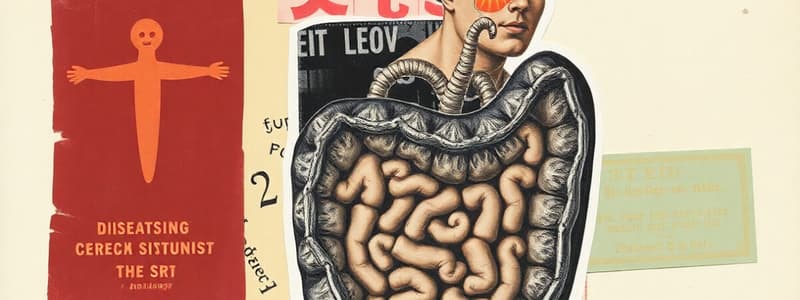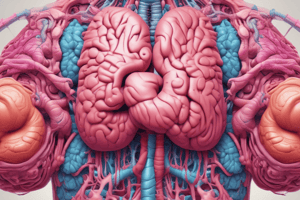Podcast
Questions and Answers
What is the most common portal of entry for pathogens into the gastrointestinal system?
What is the most common portal of entry for pathogens into the gastrointestinal system?
- Coughed up & swallowed
- Systemic blood-borne infections
- Ingestion (correct)
- Parasite migration
Which condition results in a communication between the oral and nasal cavities?
Which condition results in a communication between the oral and nasal cavities?
- Sialoadenitis
- Palatoschisis (correct)
- Stomatitis
- Cheiloschisis
What characterizes superficial stomatitis?
What characterizes superficial stomatitis?
- Associated with autoimmune disease
- Limited to the mucosa (correct)
- Involves necrotic tissue
- Extends to the submucosa
What type of pneumonia can result from Palatoschisis in animals?
What type of pneumonia can result from Palatoschisis in animals?
What is the inflammation of the gums specifically called?
What is the inflammation of the gums specifically called?
Which of the following is NOT a cause of stomatitis?
Which of the following is NOT a cause of stomatitis?
What type of stomatitis is characterized by necrotic tissue?
What type of stomatitis is characterized by necrotic tissue?
Which viral condition is specifically associated with vesicular stomatitis in large animals?
Which viral condition is specifically associated with vesicular stomatitis in large animals?
What virus is responsible for Foot and Mouth Disease?
What virus is responsible for Foot and Mouth Disease?
Which age group of animals is commonly affected by Bovine Popular Stomatitis?
Which age group of animals is commonly affected by Bovine Popular Stomatitis?
What distinguishes an ulcer from an erosion in stomatitis?
What distinguishes an ulcer from an erosion in stomatitis?
What clinical finding is associated with Gray/yellow myocardial necrosis in affected animals?
What clinical finding is associated with Gray/yellow myocardial necrosis in affected animals?
What kind of bacterium is responsible for calf diphtheria?
What kind of bacterium is responsible for calf diphtheria?
Which of the following describes a granulomatous condition?
Which of the following describes a granulomatous condition?
What is a common feature of necrotizing stomatitis?
What is a common feature of necrotizing stomatitis?
What is the primary lesion type seen in Actinobacillosis?
What is the primary lesion type seen in Actinobacillosis?
What is one potential sequelae of dental caries?
What is one potential sequelae of dental caries?
Which type of esophagitis is associated with repeated gastric acid reflux?
Which type of esophagitis is associated with repeated gastric acid reflux?
Which condition is characterized by the protrusion of the mandible?
Which condition is characterized by the protrusion of the mandible?
What type of tumor is a squamous cell carcinoma classified as?
What type of tumor is a squamous cell carcinoma classified as?
Which of the following is NOT a sequelae of choke in the esophagus?
Which of the following is NOT a sequelae of choke in the esophagus?
Which of the following conditions is associated with abnormal wear and may follow dental trauma?
Which of the following conditions is associated with abnormal wear and may follow dental trauma?
What is a characteristic feature of a benign tumor referred to as an epulis?
What is a characteristic feature of a benign tumor referred to as an epulis?
Which condition is a potential consequence of intra-uterine infection with BVD in cows?
Which condition is a potential consequence of intra-uterine infection with BVD in cows?
Flashcards are hidden until you start studying
Study Notes
Oral Cavity & Pharynx
- The oral cavity is a part of the digestive system that includes the oral mucous membranes, teeth, tonsils, salivary glands, and tongue
- Pharynx is the part of the digestive system that connects the oral cavity to the esophagus
Esophagus
- The esophagus is a muscular tube that connects the pharynx to the stomach
Stomach
- The stomach is a muscular sac that stores and mixes food
- There are two types of stomachs - Simple and complex stomachs
Intestines
- The intestines are a long, coiled tube that digests and absorbs food
- The intestines can be divided into two parts- the small intestine and the large intestine
- The small intestine is responsible for most of the digestion and absorption of nutrients.
- The large intestine absorbs water and electrolytes.
Liver & Pancreas
- The liver is a large organ that produces bile, which helps digest fats.
- The pancreas is a gland that produces enzymes that help digest food.
Peritoneum
- The peritoneum is a membrane that lines the abdominal cavity and covers the organs within it.
Signs of GI Disease
- Signs of GI disease can include vomiting, diarrhea, constipation, abdominal pain, and weight loss
Portals of entry of Pathogens
- The most common route of entry for pathogens is by ingestion
- Pathogens can enter the body through coughed up material that is swallowed
- They can also enter the body through systemic blood-borne infections
- Parasite migration can be a portal of entry for some pathogens.
Oral Cavity
- The oral cavity is the first part of the digestive system
- Oral cavity contains: oral mucous membranes, teeth, tonsils, salivary glands, and tongue
- Oral mucous membranes are a protective lining for the mouth
- The teeth are used for chewing food
- The tonsils are lymphatic tissues that help fight infection
- The salivary glands produce saliva, which helps moisten food and begin digestion
- The tongue helps move food around in the mouth and helps with swallowing
Palatoschisis (Cleft Palate)
- Palatoschisis is a fissure in the hard palate resulting in a connection between the oral and nasal cavities
- It can lead to aspiration pneumonia
Causes of Palatoschisis
- Palatoschisis can be caused by genetic factors and toxic plants such as Veratrum californicum
Cheiloschisis (Cleft Lip or Hare Lip)
- Cheiloschisis is a fissure in the lip
Stomatitis
- Stomatitis is an inflammation of the oral cavity
- Different types of stomatitis are: cheilitis (lips), glossitis (tongue), gingivitis (gums), pharyngitis (pharynx), tonsillitis (tonsils), and sialoadenitis (salivary glands)
Causes of Stomatitis
- Stomatitis can be caused by infectious agents, trauma, chemical injury, autoimmune diseases, and systemic diseases
Classification of Stomatitis
- Superficial stomatitis: Limited to the mucosa
- Vesicular stomatitis
- Erosive and ulcerative stomatitis
- Deep stomatitis: Extended to the submucosa
- Necrotic stomatitis
- Granulomatous stomatitis
Vesicular Stomatitis
- Characterized by vesicle formation - vesicle: Fluid-filled raised lesion
- It is caused by epithelial damage (viral)
- It leads to intracellular and intercellular edema, which results in erosion, ulcers, and cellular infiltration
Vesicular Stomatitis in Dogs & Cats
- It is mainly caused by autoimmune disease (in dogs & cats) and calicivirus infection (in cats)
Vesicular Stomatitis in Food Animals
- Foot and mouth disease (in cattle sheep, Pigs)
- Vesicular stomatitis (in Horse, cattle, Pig)
Foot and Mouth Disease
- It is highly contagious and affects mainly ruminants and pigs
- Caused by picornavirus
- It can lead to vesicles which rupture leading to ulcers
- It can also lead to gray/yellow myocardial necrosis (“tiger heart”) in animals less than 6 months of age
Erosive & Ulcerative Stomatitis
- Erosion: Loss of surface epithelium with intact basement membrane
- Ulcer: Loss of the epithelium with destruction of the basement membrane, revealing the underlying submucosa (blood vessels)
- Erosive & Ulcerative Stomatitis can be caused by: BVD, MCF, Rinderpest, Peste des petits ruminants, Bluetongue, FMD, Herpesvirus(Cattle, cats, horses, primates), and Uremia
Necrotizing Stomatitis
- Characterized by tissue necrosis
- Example: Calf diphtheria caused by Fusobacterium necrophorum
Granulomatous Stomatitis
- Characterized by granuloma formation
- Example: Actinobacillosis(wooden tongue) - caused by Actinobacillus lignieresii (Gram negative)
- Affects cattle, sheep
- Grossly: The tongue is firm, pale containing multifocal nodules, containing Yellow pus "sulfur granules," and has a massive amount of fibrous connective tissue
- Microscopically: a pyogranuloma - composed of mass of bacteria, radiating eosinophilic clubs, neutrophils, macrophages, giant cells, lymphocytes, plasma cells, and a fibrous connective tissue capsule
Feline Eosinophilic Granuloma
- It is a type of granulomatous stomatitis that affects cats
Lymphoplasmacytic Stomatitis
- Characterized by lymphocytes and plasma cells
- Example: Feline gingivostomatitis (FGS)
Benign Tumors and Tumor-like Masses
- Gingivial hyperplasia
- Epulis
- Papilloma (wart)
Malignant Tumors
- Squamous cell carcinoma
- Malignant melanoma
- Fibrosarcoma
Teeth
- Teeth are used for chewing food
- Anomalies in teeth can cause malocclusion
Anomalies of Teeth
- Prognathia: Protrusion of the mandible
- Brachygnathia: Short mandible, which can lead to malocclusion
Enamel Dysplasia
- Enamel dysplasia can be caused by canine distemper in puppies and BVD intra-uterine infection.
Attrition & Abnormal Wear
- Attrition and Abnormal wear can lead to dental infection and dental trauma.
Caries
- Caries is the acid demineralization of tooth and enzymatic digestion of dental organic matrix followed by inflammation
- Dental plaque (bacterial film + food + organic matrix) can lead to caries
- Dental calculus or tartar (mineralized plaque) can also lead to Caries
- Sequelae of carries: Loss of tooth, Alveolar osteomyelitis, Tooth abscess, Pulpitis, Bacteremia
Esophagus
- The esophagus is a muscular tube that connects the pharynx to the stomach
- Choke is when the esophagus is blocked usually by food
- It can lead to stenosis, rupture, perforation, and bloat
Esophagitis
- Esophagitis is inflammation of the esophagus
- Reflux esophagitis: due to repeated gastric acid reflux
- Ulcerative esophagitis: caused by BVD, bovine popular stomatitis
- Parasitic esophagitis: caused by Sarcocystosis (Cow), Spirocerca lupi (Dog)
Megaesophagus
- Megaesophagus is a condition where the esophagus is enlarged
- It can be congenital or acquired
Studying That Suits You
Use AI to generate personalized quizzes and flashcards to suit your learning preferences.




